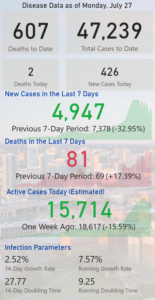15 COVID-Related Deaths Reported Tuesday
As new confirmed cases of COVID-19 vary wildly from day to day, getting a handle on what is going on can be an arduous task. Here are today’s bullet points.
- 15 COVID-related deaths reported Tuesday;
- State death count increases after change in tallying method;
- Abbott extends deadline for pandemic food benefits
15 COVID-Related Deaths Reported Tuesday
Dallas County health officials reported 789 confirmed cases of COVID-19 Tuesday, bringing the total case count to 48,028. The county also reported 15 deaths, bringing that total to 622.
Among the dead are a Dallas man in his 50s who was found dead at his home and had no underlying health conditions, a Grand Prairie man in his 50s, a Lancaster man in his 50s, a Garland man in his 60s, an Irving woman in her 60s, an Irving man in his 60s, a Mesquite woman in her 70s, an Irving woman in her 80s, a Richardson man in his 80s, a Dallas woman in her 80s, and a Grand Prairie man in his 90s.
Additionally, a man in his 70s who was an inmate at a correctional facility in Seagoville died.
Long-term care facilities continue to account for a third of all COVID-19 deaths, including a man in his 90s who lived in a DeSoto facility, two women in their 90s who lived in Dallas facilities. Both died at their respective facilities.
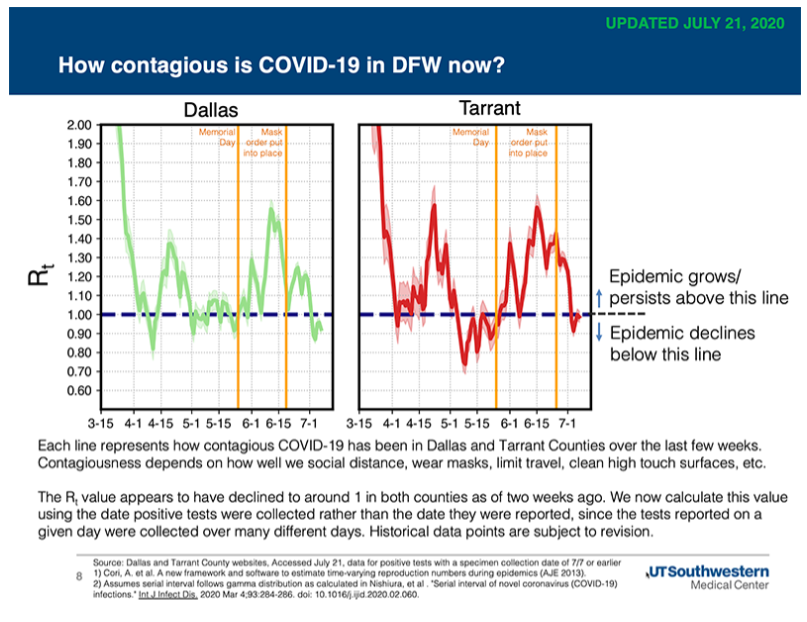
“Today’s numbers, while higher than yesterday, continue the trend of being lower than we saw two weeks ago. In looking at the numbers, it’s important to focus not on the daily numbers but on the seven day and fourteen day rolling averages,” said Dallas County Judge Clay Jenkins. “If you continue to wear your mask around people outside your household, maintain six foot distancing from people outside your household, limit trips to necessities only and use good hygiene, we will see the numbers go down.
“I know it’s hot and the mask can be uncomfortable at times, but it’s a small price to pay to keep us safe, strengthen our economy, and get our kids back to school. The decisions each of us make have a big impact on the numbers and all of us have an important role to play in controlling the spread of COVID-19.”
The county said that the number of COVID-19 hospitalizations Monday was 697 patients. Emergency room visits for COVID-19 symptoms also remain high, representing about 22% of all ER visits, according to information reported to the North Central Texas Trauma Regional Advisory Council.
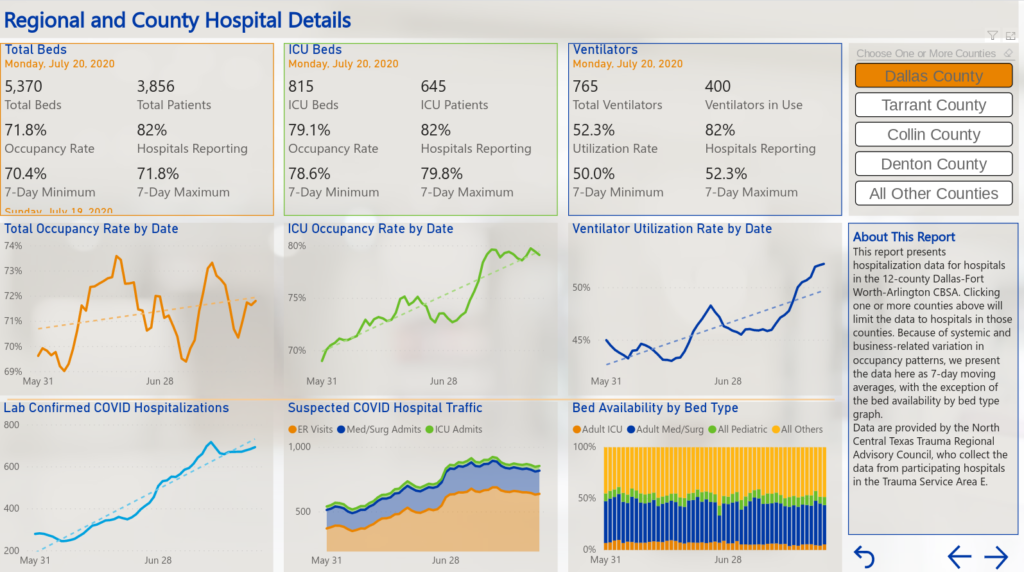
The Tuesday data from the Institute for Urban Policy Research, which collects data from the North Central Texas Trauma Regional Advisory Council, shows that in Dallas County, roughly 82% of hospitals are reporting, and the occupancy rate is somewhere near 72%, but almost 80% of all available ICU beds are in use, and more than half of all ventilators are in use.
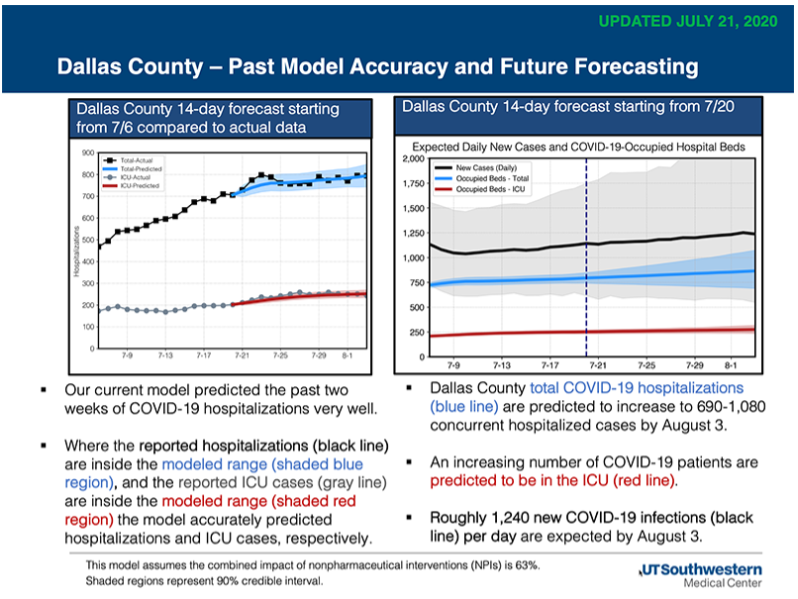
UT Southwestern’s latest forecast projects that by Aug. 3, Dallas County hospitals could see concurrent hospitalizations from COVID-19 increase to between 690 and 1,080 cases. Hospitalizations in the Dallas-Fort Worth area have increased by 2% in a week, and 107% compared to a month ago. In Dallas County, hospitalizations have increased by 6% in a week and 88% compared to a month ago.
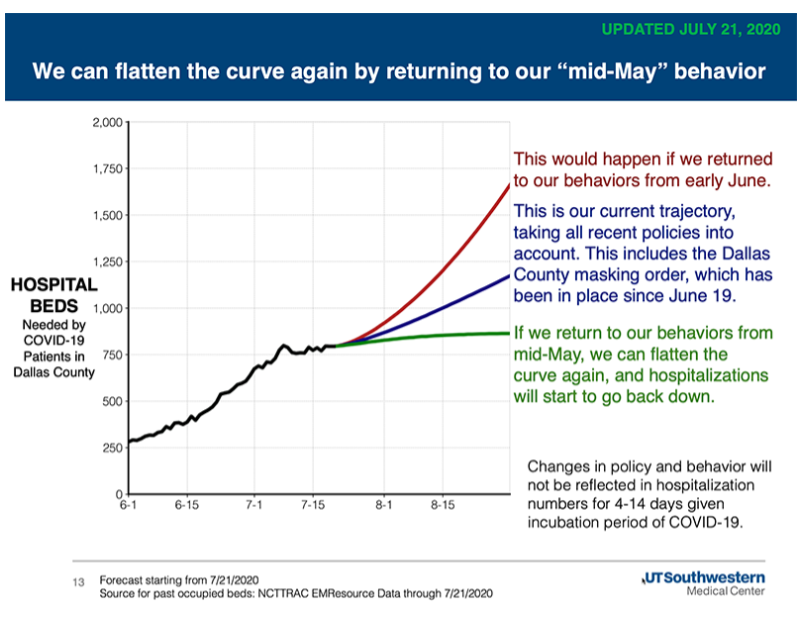
In the county’s July 24 aggregate report, most cases continue to be between the ages of 18 and 60, with the 18-40 age group accounting for 46% of the cases, and the 41-64 age group accounting for another 35% of the total cases. The zero to 17 age group now accounts for 10% of all cases since the start of the pandemic.
More than 1,800 children 18 or younger have been diagnosed with COVID‐19 since July 1, including 38 children who have been hospitalized for COVID‐19 and four admitted to intensive care units.

Close contact or community transmission continues to be the biggest risk factor for contracting COVID-19, accounting for roughly 91% of all cases. Being incarcerated in a federal prison, living in a long-term care facility or being incarcerated in the county jail are a distant second, third, and fourth, at 2.8%, 2.3% and 1.4%, respectively.
Of the testing done, positive cases accounted for 21.7% as of July 18, with 2,058 positives coming from 9,488 tests. Testing and positive test results of COVID-19 far outpaces any other respiratory virus – even if you combine them all.
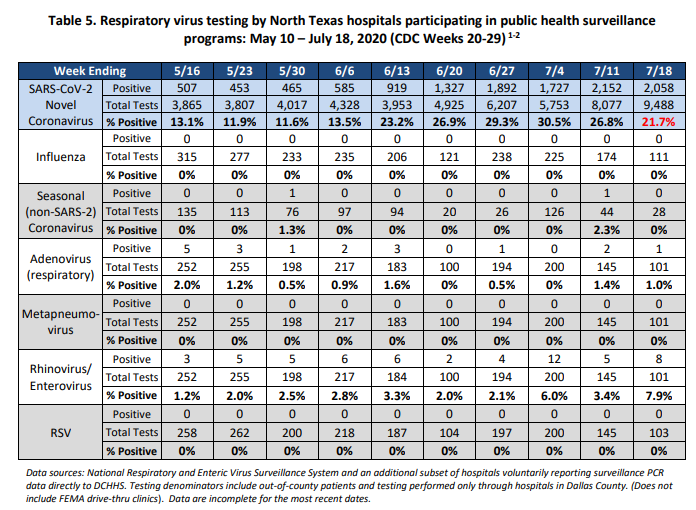
Thirteen percent of all cases ended up hospitalized (up from the 12% it has been for several weeks) – 21% ended up in intensive care, and 11% ended up on a ventilator.
In a city-by-city breakdown, Dallas still comes in with the highest number of cases – 23,931, or 53.5%. Highland Park has 41 (up from 39 last Tuesday) cases so far, and University Park has 72.
State Death Count Increases After Change in Tallying Method
After the state of Texas made adjustments to the way it tallies COVID-19 related deaths, it was discovered that the state was underreporting such deaths by as much as 12%, the Texas Tribune reported Monday.
The Texas Department of State Health Services now counts deaths where COVID-19 is marked as a cause of death on a death certificate. Prior to that, the state relied on local and regional public health departments to report those deaths.
“This method allows fatalities to be counted faster with more comprehensive demographic data,” the DSHS said in a press release. “Using death certificates also ensures consistent reporting across the state and enables DSHS to display fatalities by date of death, providing the public with more information about when deaths occurred.”
Death certificates are required to be filed within 10 days of the death. A death is counted as being the result of COVID-19 when a medical certifier – usually a treating physician – determines that the death was the direct result of the virus. This new method does not include people who had COVID-19, but died of unrelated causes.
The state’s count grew by more than 600 Monday when it made the switch, indicating that more than 12% of the state’s previous tally was unreported.
Abbott Extends Deadline for Pandemic Food Benefits

Gov. Greg Abbott announced Tuesday that the Texas Health and Human Services Commission (HHSC) is extending the application deadline for the federal Pandemic-Electronic Benefit Transfer program (P-EBT) to Aug. 21 to ensure eligible families have more time to apply for this one-time food benefit.
P-EBT is a one-time benefit of $285 per eligible child and can be used in the same way Supplemental Nutrition Assistance Program (SNAP) food benefits pay for groceries. Eligible families include those with children who lost access to free or reduced-price school meals through the National School Lunch Program (NSLP) due to school closures.
“The P-EBT program helps ensure that families continue to have access to healthy food as some schools, and subsequently school lunch programs, remain closed due to COVID-19,” said Abbott. “I encourage eligible Texans to apply for these benefits so they can continue to provide food for their families during these challenging times.”
HHSC partnered with the Texas Department of Agriculture and the Texas Education Agency to launch the $1 billion federal program on June 1 in response to the COVID-19 pandemic. More than 3 million children in Texas were certified to receive free or reduced-price meals at school during the 2019-2020 school year. To date, nearly $790 million in P-EBT has been issued to families, benefiting more than 2.8 million children. Families who are eligible for P-EBT were notified by their school districts in May. After completing the online application, families receive their benefits on a new Texas P-EBT card in the mail.
Families who have been denied but think they are eligible should contact HHSC within 15 days of receiving their denial notice. They can either call the P-EBT Call Center at 833-613-6220 or send an email to AES_PEBT_Complaints@hhsc.state.tx.us with proof of free or reduced-priced meals. Proof includes the award letter that is sent to parents when their children become eligible for the National School Lunch Program.
To apply for benefits, including SNAP and Medicaid, at YourTexasBenefits.com.


